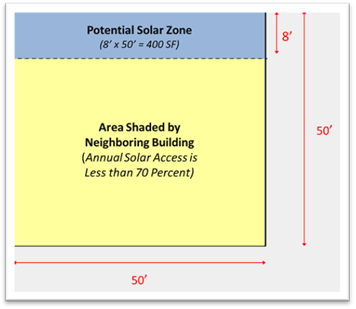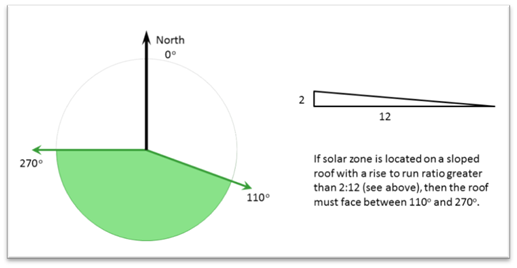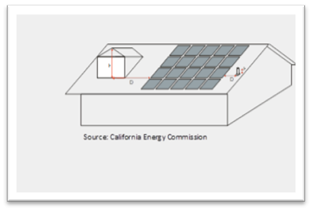7.6 Solar
Ready Overview
The solar ready provisions are
mandatory for low-rise residential buildings that do not have a PV system due to an
exception in Section 150.1(c)14. There are exceptions to the “solar zone”
requirements, and these are described in the corresponding sections of this
chapter. Because solar ready is mandatory, CF1R-SRA-01-E compliance forms must
be submitted with the building permit application, even when using an allowable solar
zone exception.
Please note: In §110.10
of the Energy Standards, the solar zone, interconnection pathways, and
design load requirements for low-rise multifamily buildings are located with the
high-rise multifamily requirements in §110.10(b)1B.
Because most of the low-rise multifamily requirements are identical to high-rise
(including three Exceptions), Chapter
9 of the “Nonresidential
Compliance Manual” is an additional resource for technical assistance.
7.6.1
Covered Occupancies
The low-rise residential
solar-ready requirements only apply to new single-family homes and low-rise
multifamily buildings that do not have a PV system, as described in A and B below.
A.
Single-Family Residential Buildings
The solar-ready
requirements apply to the following newly constructed single-family homes
without a PV system, and:
•
located in a subdivision with 10 or more residences and
•
the Tentative Subdivision Map is complete and approved by the enforcement agency.
B.
Low-rise Multifamily Residential Buildings
The solar ready
requirements apply to low-rise multifamily buildings having three habitable
stories or fewer without a PV system.
A note about Mixed Occupancy
Buildings: The Energy Standards apply to mixed occupancy buildings. Low-rise
buildings with nonresidential space on the ground floor and multi-family
residential floors above are common examples. The Solar Zone requirements include
mixed occupancy buildings.
7.6.2
Solar Zone
The solar zone is a suitable place where
solar panels can be installed at a future date - if the owner chooses to do so.
A solar zone area is designed with no penetrations, obstructions or significant
shade. The solar zone must comply with the access, pathway, smoke ventilation,
and spacing requirements in Title 24 Part 9. Requirements from the other parts of Title 24,
and those adopted by a local jurisdiction should also be incorporated in the
solar zone design.
For single-family homes, the
solar zone must be located on its roof or overhang.
For low-rise multifamily
buildings, the solar zone can be located on any of the following locations:
1.
Roof of the building.
2.
Overhang of the building.
3.
Roof or overhang of another structure located within 250 feet of the primary
building.
4.
Covered parking installed with the building project.
See Figure 7-6 for some
acceptable solar zone placement techniques.
7.6.2.1 Solar Zone Minimum
Area
The total
area of the solar
zone may be composed of multiple subareas - if they meet minimum size
specifications. No dimension of a subarea can be less than five feet. If the
total roof area is
equal to or less than 10,000 square feet, each subarea must be at least 80
square feet. If the total roof area is greater than 10,000 square feet, each
subarea must be at least 160 square feet.
7.6.2.2 Solar Zone Area for
Single-Family Residential Buildings
The solar zone must be located on the roof or overhang of the building. The
“designated” solar zone’s total area must be no less than 250 square feet
(§110.10(b)1A).
There are six allowable
exceptions to the required solar zone area. Exceptions 1 and 6 allow alternate
efficiency measures instead of an actual solar zone, so the requirements for
zone shading,
azimuth and design load; interconnection pathway, owner documentation, and
electric service
panel do not apply either.
Submit a CF1R-SRA-01-E to
the building department with the building permit application for
all projects covered by solar ready, even when using a Solar Zone Exception. In
addition, submit
a CF1R-SRA-02-E solar zone worksheet for all projects with a solar zone,
including Exceptions that allow a reduced solar zone area.
Solar Zone Exceptions for
Single-family Buildings:
Exception 1 may
apply when a domestic solar water-heating (SWH) system is permanently installed at the
time of construction. The SWH system must comply with the installation criteria
in the Reference Residential Appendix RA4,
and have a minimum solar savings fraction of 0.50. Note: These buildings are
also exempt from the interconnection pathway, documentation and electrical panel
requirements because there is no solar zone.
Exception 2 may
apply if the single-family home has three or more habitable stories and a total
floor area ≤ 2,000 square feet. The designated solar zone may be reduced. The
area must be ≥ 150 square feet.
Exception 3 may
apply if the single-family home is in the Wildland-Urban Interface Fire Area (as
defined in Title
24, Part 2). The solar zone area may be reduced to ≥ 150 square feet. In
addition, a whole-house fan must be permanently installed at the time of
construction. This exception is intended to accommodate attic- and roof-venting requirements in
these fire areas.
New in the
2019 Energy Standards: this exception may be used in all Climate Zones.
Exception 4 reduces
the solar zone area when the roof is shaded by objects that are not part of the
building project, and therefore beyond the designer’s control. The
designated solar zone may be reduced to ≥ 50 percent of the potential solar zone
area when solar access is limited as described below. When the “potential” solar
zone is smaller than the 250 square feet minimum, the solar zone can be reduced
to half the area of the potential solar zone. The reduced-size solar zone is
called the “designated” solar zone.
Exceptions for
Reduced Solar Zone Due to Shade
Step
1: Determine the Annual Solar Access: For the solar ready requirements, solar
access is the ratio of solar insolation including shading to the solar
insolation without shading. Annual solar access is most easily determined using
specialized software.
Solar Access=(Solar Insolation Including Shading)
(Solar Insolation Without Shading)
Solar
access does not take into account shading from objects that are included in the
building project because the designer has control of potential obstructions.
Objects that are not part of the building project cannot be moved or modified as
part of the project and include existing buildings, telephone poles,
communication towers, trees, or other objects. Objects that are considered part
of the building project are objects constructed as part of the building project
and include the building itself, its HVAC equipment, outdoor lights, landscape
features and other similar objects.
First
evaluate whether there are any objects outside the building project that will
shade the rooftop (or other prospective solar zone areas such as overhangs or
parking shade structures). If an existing object is located north of all
potential solar zones, the object will not shade the solar zone. Similarly, if
the horizontal distance (“D”) from the object to the solar zone is at least two
times the height difference (“H”) between the highest point of the object and
the horizontal projection of the nearest point of the solar zone, then the
object will not shade the solar zone (See Figure 7-4).
Step
2: Determine the Potential Solar Zone Area: On low-sloped roofs, the potential
solar zone is the area where annual solar access is ≥ 70 percent.
On
steep-sloped roofs the potential solar zone is the area where the annual solar
access is ≥ 70 percent on the portion oriented between 90 and 300 degrees of
true north.
Step
3: Determine the size of the designated solar zone. The designated solar zone
must be ≥ 50 percent of the potential solar zone area. If the roof is shaded
such that there is no potential solar zone area, then no solar zone is required.
See Figure 7.1. Document the method/tools used to demonstrate that the solar
access is less than 70 percent in the compliance form CF1R-SRA-02-E (Minimum
Solar Zone Area Worksheet).
Example
7-13
Question:
A house has a
total roof area of 2,500 SF. The neighbor’s house and trees shade the roof, so
2,100 SF of the roof has less than 70 percent annual solar access. How big does
the solar zone have to be?

Answer:
If the
entire roof were to have an annual solar access of 70 percent or greater, the
minimum solar zone would have been 250 SF. Since the potential solar zone is
only 2,500 – 2,100 = 400 SF, however, the minimum solar zone can be reduced to
50 percent of the potential solar zone, or 200 SF.
Exception 5 allows a
reduced solar zone of ≥ 150 square feet if all thermostats have demand
responsive controls. See Appendix H of this compliance
manual for guidance
on compliance with the demand responsive
control requirements.
Exception 6 allows
no solar zone when the following energy efficiency features are installed:
All thermostats have demand responsive controls that comply
with Section
110.12(a) and Joint Appendix JA5.
(please see Exception 5, above, for more details). AND one of the following four
measures (i – iv):
i.
Install a dishwasher that meets or exceeds the ENERGY STAR® program requirements
with a refrigerator that meets or exceeds the ENERGY STAR program requirements,
OR one of the followings:
• a whole-house fan driven
by an electronically commutated motor, OR
• an SAE J1772 Level 2 Electric Vehicle
Supply Equipment (EVSE or EV Charger) with a minimum of 40 amperes. SAE J1772
is the SAE International document titled “SAE Electric Vehicle and Plug in
Hybrid Electric Vehicle Conductive Charge Coupler” (SAE J1772_201710).
ii.
Install a home automation system that is capable of, at a minimum, controlling
the appliances and lighting of the dwelling and responding to demand response signals; OR
iii.
Install alternative plumbing piping to permit the discharge from the clothes
washer and all showers and bathtubs to be used for an irrigation system in
compliance with the California Plumbing Code; OR
iv.
Install a rainwater catchment system designed to comply with the California
Plumbing Code and uses rainwater flowing from at least 65% of the available
roof area.
Example
7-14 Solar Ready Zone
Question:
What
are the examples of how the solar ready zone requirements can be avoided using
Exception 6?
Answer:
Exception
6 provides three options for avoiding the solar ready zone requirements
altogether:
1.
Install only demand responsive capable (DRC) thermostats with ENERGY STAR®
dishwasher and refrigerator, or
2.
Install only DRC thermostat(s) and a whole-house fan driven by an electronically
commutated motor, or
3.
Install only DRC thermostat(s) and a level 2 EV charger with a minimum of 40
amperes.
Any
of these three options can be used to avoid the solar ready zone
requirements.
Solar Zone Area for Low-Rise Multifamily Residential
Buildings
The solar zone requirement for
low-rise multifamily buildings is located in the 2019 Energy Standards with the
requirements for high-rise multifamily, hotel/motel and nonresidential
buildings in §110.10(b)1B.
The solar zone requirement for low-rise multifamily buildings applies to mixed
occupancy
buildings as well.
The solar zone must be located on the
roof or overhang of the building, or on the roof or overhang of another
structure located within 250 feet of the building, or on covered parking
installed with the building project. The solar zone’s total area must be ≥ 15
percent of the building’s total roof area. Subtract any skylight area when calculating
the roof’s total area.
Four solar zone exceptions apply to
low-rise multifamily buildings in the 2019 Energy Standards. Exception 3
allows a smaller solar zone under certain circumstances. Exceptions 4 and 5
allow alternate efficiency measures in lieu of a solar zone. Therefore, the
requirements for solar zone shading, azimuth and design load; interconnection
pathway, and documentation do not apply.
Exceptions 1 and 2 do not
apply to low-rise multifamily buildings.
Exception 3 reduces the solar
zone area when the roof is shaded by objects that are not part of the building
project, and therefore beyond the designer’s control. The reduced-size solar
zone is called the “designated” solar zone. The designated solar zone may be
reduced to ≥ 50 percent of the potential solar zone area when solar access is
limited. Solar access is the ratio of solar insolation including shade to amount
of solar insolation without shade. Shading from obstructions on the roof or
other parts of the building cannot be included to determine annual solar
access.
See Figure 7-2 for more
information about calculating the designated solar zone.
•
Low-sloped roof: the potential solar zone area is the total
area of any roof where annual solar access is 70% or greater.
•
Steep-sloped roof: The potential solar zone area is the roof area where
annual solar access is 70% or greater and oriented between 90 and 300 degrees of
true north.
Exception 4 says
multifamily residential buildings do not need a solar zone if all thermostats
have demand responsive controls that comply with Section
110.12(a) and Joint Appendix JA5.
See Exception 5 for single-family homes (above) for more thermostat details. In
addition to the compliant thermostats, choose A or B below:
A.
One of the following four measures installed in each dwelling unit (i. – iv.):
i.
Install a dishwasher that meets or exceeds the ENERGY STAR® program requirements
with a refrigerator that meets or exceeds the ENERGY STAR program requirements,
or a whole-house fan driven by an electronically commutated motor.
ii.
Install a home automation system that complies with §110.12(a) and is capable
of, at a minimum, controlling the appliances and lighting of the dwelling and
responding to demand response signals; or
iii.
Install alternative plumbing piping to permit the discharge from the clothes
washer and all showers and bathtubs to be used for an irrigation system in
compliance with the California Plumbing Code; or
iv.
Install a rainwater catchment system designed to comply with the California
Plumbing Code and that uses rainwater flowing from at least 65 percent of
the available roof area.
B.
Meet the Title 24 Part 11, Section A4.106.8.2 requirements for electric vehicle
charging spaces.
Exception 5
includes low-rise multifamily buildings and says a solar zone is not required
when the roof is designed and approved to be used for vehicular traffic, or parking, or a
heliport.
7.6.3
Azimuth (Solar Zone)
For both single-family
residential and low-rise multifamily buildings, all sections of the solar zone on
steep-sloped roofs (ratio of rise to run of greater than 2:12) must be oriented
between 90 degrees and 300 degrees of true north. The orientation is important
because it ensures a reasonable solar exposure if a solar energy system is installed in
the future. On a low-sloped roof (ratio of rise to run of 2:12 or less), the
azimuth requirement does not apply.
Figure 7-4: Orientation when solar zone is located on a
steep-sloped roof

7.6.4
Shading (Solar Zone)
For both single-family
residential and low-rise multifamily buildings, the solar zone must be free from roof penetrations and
shall not have any obstructions such as vents, chimneys, architectural features,
or roof-mounted equipment located in the solar zone. This requirement ensures
that the solar zone remains clear and open for the future installation of a
solar energy system.
Any obstruction located on
the roof or any other part of the building that projects above the solar zone must be located at
a sufficient horizontal distance away from the solar zone in order to reduce the
resulting shading
of the solar zone. For each obstruction, the horizontal distance (“D”) from the
obstruction to the solar zone shall be at least two times the height difference
(“H”) between the highest point of the obstruction and the horizontal projection
of the nearest point of the solar zone.

Figure 7-5:
Schematic of Allowable Setback of Rooftop Obstructions

Any obstruction oriented north of all
points of the solar zone is not subject to the shading requirement. Any
obstruction that is not located on the roof or another part of the building,
such as landscaping or neighboring building, is not subject to the shading
requirement.
7.6.5
Structural Design Loads (Solar Zone)
The structural design loads for roof dead load and roof
live load must be clearly indicated on the construction documents for the
designated solar
zone areas. The structural load information will be easily available if the
building
owner considers a solar energy system installation in the future. It is not necessary to
estimate the collateral loads for future solar energy systems.
The structural design loads
requirement applies to the solar zone on both single-family residential and
low-rise multifamily buildings.
7.6.6
Interconnection Pathways
All buildings that comply by
designating a solar
zone must also include a plan for connecting a future PV and SWH system to the
building’s electrical or plumbing system. The construction documents must
indicate:
1.
A reserved location for inverters and metering equipment for solar electric
systems.
2.
A reserved conduit route from the solar zone to the point of interconnection
with the electrical service. There is no requirement to install any conduit.
3.
For single family residences, and multifamily buildings with a central water
heating system, a reserved plumbing pathway from the solar zone to the
water-heating system connection. There is no requirement to install any
plumbing.
This requirement applies to
both single-family residential and low-rise multifamily buildings.
7.6.7
Documentation
A copy of the construction
documents or a document containing the required solar-ready information must be
provided to the occupant. The building occupant must also receive a copy of compliance forms
CF1R-SRA-01-E and CF1R-SRA-02-E. Providing this information to the
building occupant is required so the information is available if the owner
decides to install a solar energy system in the future. Construction documents must include
information about the as-designed structural loads, solar zone location, and the
reserved interconnection pathways. This requirement applies to both
single-family residential and low-rise multifamily buildings.
7.6.8
Main Electrical Service Panel
This requirement applies
only to single-family residential buildings. The main electrical service panel must
have a minimum Busbar rating of 200 amps. The panel must also include space to
install a double-pole circuit breaker in the future, if one is not installed
during construction. These items are required to simplify the possible future
installation of a solar electric system.



